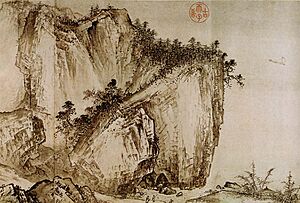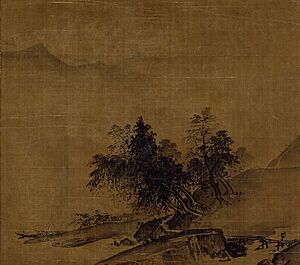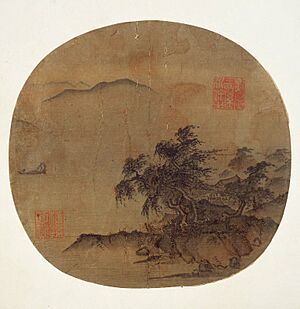Xia Gui facts for kids
Quick facts for kids
Xia Gui
|
|
|---|---|

A close-up from Pure and Remote View of Streams and Mountains, one of Xia Gui's most important paintings.
|
|
| Born | fl. 1195 |
| Died | 1224 |
| Nationality | Chinese |
| Known for | Painting |
| Movement | Southern Song Dynasty, Ma-Xia School |
Xia Gui (pronounced Hsia Kui) was a famous Chinese landscape painter from the Song dynasty. He lived from about 1195 to 1224. His courtesy name was Yuyu.
We don't know much about his life, and only a few of his paintings are still around. But many people think he was one of China's best artists ever! Xia Gui followed the style of an older painter named Li Tang. He made the Song painting style even simpler, which made his art look very striking and direct.
Together with another artist, Ma Yuan, he started the "Ma-Xia" (馬夏) school of painting. This was one of the most important art styles of that time. Even though Xia Gui was popular when he was alive, his fame faded after he died. However, some artists, like the Japanese master Sesshū, continued to use Xia's style for hundreds of years.
About Xia Gui's Life
We don't have much information about when Xia Gui was born or died. We also don't know much about his family or how he learned to paint. He was probably born in Hangzhou, which was the capital city of Southern Song China.
During the rule of Emperor Ningzong, Xia Gui worked in the Imperial Painting Academy. This was a special art school in the capital city. Most important artists of that time worked there. We don't know who taught Xia Gui, but his paintings show he was greatly influenced by Li Tang. Li Tang was a well-known academy painter whose style affected almost all Chinese landscape painters in the 12th century.
Xia Gui and his friend Ma Yuan were very important painters in their time. They had many students who followed their style. These artists are now part of what we call the Ma-Xia school.
Later on, after the 16th century, art from the Southern Song Academy was not as popular. Because of this, Xia Gui's fame went down. But some art critics still thought his paintings were among the best from the Song Dynasty. Some Chinese artists continued to create art inspired by Xia's unique style.
A Japanese artist named Sesshū Tōyō visited China in the 15th century. He was very impressed by Xia Gui's work and his followers. Sesshū Tōyō even made copies of Xia Gui's landscape fan paintings. Two of these copies, signed by Sesshū Tōyō, are still in Japan today. Sesshū's many students, known as the Unkoku-rin School, sometimes copied the style their teacher learned from Xia.
Xia Gui's Artworks
Most of Xia Gui's paintings that still exist are small album leaves. These were a favorite type of painting for artists in the Song Academy. One painting that all experts agree is a real Xia Gui work is the album leaf called Sailboat in Rainstorm. It is kept at the Museum of Fine Arts, Boston.
Instead of making very detailed and complex paintings, Xia Gui used fewer materials. This helped him create a more direct and powerful effect. Xia Gui was one of many artists who followed Li Tang's style. However, Xia soon developed his own special way of painting.
Two examples of his album leaf paintings are in the Tokyo National Museum. Both of these ink-on-silk paintings show a perfect balance. Empty spaces and solid shapes are equally important in his art. He also used amazing ink techniques.
Xia Gui's skills are even more impressive in his long hand scrolls. But only a few of these have survived. The most famous one is the 9-meter (30-foot) long Pure and Remote View of Streams and Mountains. This painting is done with ink on paper. It is not complete, as the last part, where the artist's signature would be, is missing.
In this painting, Xia Gui used very soft, blended ink washes and overlapping brushstrokes. This created amazing effects of mist, sky, and endless space.
Other hand scrolls by Xia Gui include Ten Thousand Miles of the Yangzi River. However, only a copy from the 16th century, which might not be accurate, still exists. Another scroll is Twelve Views from a Thatched Hut. Several copies of this one exist. The original is probably the broken scroll at the Nelson-Atkins Museum of Art in Kansas City, Missouri, United States.
Hanging scrolls by Xia Gui are very rare. The famous Rain Storm from the Kawasaki collection in Japan is now thought to be a copy. There are two hanging scrolls in the Freer Gallery of Art that might be real Xia Gui paintings. These are Rapids in a Mountain Valley (also called A Misty Gorge) and Autumn Moonlight on Dongting Lake. The first one is missing its top part, where the signature would have been.
Old writings say that Xia Gui painted very quickly and easily. Pure and Remote View of Streams and Mountains is on paper, which soaks up ink fast. This means it was likely painted very spontaneously. Xia Gui was also praised for his skill in drawing buildings and other objects without using a ruler. Some sources say he liked to use brushes with worn tips. This helped him avoid making things too smooth. He also used "split" brushes, which let him make two or more lines at the same time.
See also
- Culture of the Song dynasty
- Chinese painting
- Chinese art
- History of Chinese art



